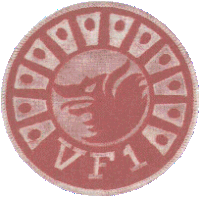
|
VF-1 Wolfpack CALLSIGN: WICHITA
CALLSIGN: WICHITA
14 Oct. 1972 - 1 Oct. 1993 Fighter Squadron ONE was originally established 1 July 1922, and continued to operate as VF-1 until 1 July 1934, at which tiem the squadron was redesignated VB-2. One year later, 1 July 1935, the second VF-1 was established and served for two years until it was again redesignated - this time VF-6. During these early years of Naval Aviation, the pilots of VF-1 flew planes such as the Curtis TS, Boeing F2B and F3B, Curtis F8C and BFC, and Boeing F4B. In January 1925, it was decided to operate VF-1 from battleships. Their TS land planes were overhauled, fitted with pontoons, and had new engines installed. The squadron's planes were assigned to eleven different battleships. On 16 November 1927, the carrier USS Saratoga was commisioned, and VF-1 was assigned to her. The 3rd VF-1 was established 1 May 1943, under leadership of Commander B. M. Strean. During the fifteen months that followed, they first thought the enemy at Tarawa and continued fighting with their F6F Hellcats in the Gilbert, Marshall, Mariana, Bonin, and Caroline Islands. The squadron was both land based and carrier based; it did night fighting, day fighting, bombing, and escort work; it operated from CVEs and a CV; it attacked the Japanese Fleet, sank 8 ships and damaged 16; it destroyed 102 airborne enemy planes plus 20 probably while losing only 5 in aerial combat; it destroyed 61 enemy planes on the ground, silenced 46 A-A batteries, and blew up or burned 10 fuel or ammunition dumps. In mid July 1944, VF-1 headed home to be reformed 1 October 1944. On 15 december, LCDR M. C. Hoffman assumed command and led the first flight onto action against Hyakurigahara and Tsukuba Airfileds north of Tokyo on 10 July. During the short combat period which followed, ending 15 August 1945, the pilots of VF-1 destroyed 38 enemy aircraft and damaged 123. They also sunk, probably sund and damamged 75,000 tons of enemy shipping. The squadron participated in the attack on Yokosuka Naval Base, Honshu, and a VF-1 pilot scored a direct hit on the enemy battleship Nasato, damaging it seriously. The squadron participated in attacks on the Kure Base which resulted in the sinking of the battleship Hyuga, a destroyer and a destroyer-escort. Crippling damage was done to the battleship Ise, two carriers Amagi and Katsuragi, two cruisers Aoba and Oyoda, and numerous smaller warships. After the hostilities ended, the squadron was assigned the important task of searching for POW camps in northern Honshu and escorting Torpedo Planes on their vital supply dropping missions. VF-1 was disestablished 25 October 1945. Established on 14th of October 1972 at NAS Miramar, at the same time as VF-2, the squadron received it's first F-14As on 1st July 1973. The squadron made the first Tomcat cruise on USS Enterprise (CVN-65) with CVW-14 from September 1974. The end of this cruise saw the Tomcat's conflict debut, as VF-1 and VF-2 flew air patrols over Saigon in April 1975 to cover the final evacuation of US personnel. VF-1 deployed aboard USS Enterprise (CVAN-65) with CVW-14 from 17 Sep 1974 to 20 May 1975. CVW-14 included the following squadrons VF-1 (F-14A), VF-2 (F-14A), VA-27 (A-7E), VA-97 (A-7E), VA-196 (A-6A " KA-6D), VAQ-137 (EA-6B), HS-2 (SH-3D), VAW-113 (E-2B), RVAH-12 (RA-5C), VQ-l Det 65 (EA-3B). VF-1 was then assigned to CVW-2, entailing a move of carrier to the USS Ranger (CV-61) in September 1980. The squadron flew several successful cruises then shifted to USS Kitty Hawk (CV-63) for a single cruise in 1984. In 1984 VF-1 achieved the impressive total of 22,000 hours of flying without accident. By 1986 VF-1 had returned to USS Ranger and was still with the carrier when she participated in Desert Storm in 1991. A plane from the squadron scored the F-14's only air to air kill of the war when NE103 (BuNo.162603) shot down an Iraqi Mil Mi-8 Hip using an AIM-9 Sidewinder. With the decommissioning of USS Ranger in 1993 the squadron was left without a carrier assignment and so operated out of NAS Miramar. The Navy's decision to reduce the number of F-14 squadrons per carrier from two to one, VF-1 was disestablished on the 1st October 1993.    |
Top of the page |
F-14 Tomcat Squadrons: VF-74 | VF-84 | VF-101 | VF-102 | VF-103 | VF-111 | VF-114 | VF-124 | VF-142 | VF-143 | VF-154 VF-191 | VF-194 | VF-201 | VF-202 | VF-211 | VF-213 | VF-301 | VF-302 | VF-1285 | VF-1485 VF-1486 | VX-4 | VX-9 | NAWC | NATC | NFWS | NASA | Iranian Air Force Carrier Airwings | Squadron Awards F-14 Tomcat: Other Topics: Start Page Foreword FAQ Updates Copyright © by Torsten Anft |